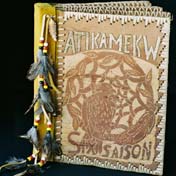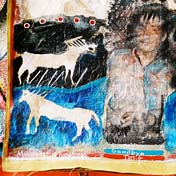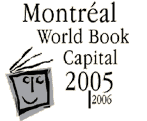

|
 |
|||
| artists' books - Ginette Aubin - moz8biak, beads and beading | |||
| GRANDE BIBLIOTHÈQUE > FROM JUNE 13 TO AUGUST 30, TUESDAY TO FRIDAY FROM 10 A.M. TO 10 P.M., SATURDAY AND SUNDAY FROM 10 A.M. TO 5 P.M.
TRAILS AND TERRITORIES, HOW MEMORY TRAVELS.
This specific, intimist art form is also called a book-object. Words undergo metamorphosis. They become tangible – turn into rhythm, visual games, images or concrete objects. This creation lies on the borderline between books and sculpture. Artists’ books emphasise the overlap between disciplines, fields of experimentation and processes rather than their own limits. The balance or tension between the materials and thought become a vehicle to convey the artistic expression each work embodies. Concepts such as page, text, image or illustration, binding and narration take on unexpected meanings. Signs, shapes, content and context create unique ensembles. We gain access to an imaginary world through a book whose pages keep on turning. SPACES OF CREATION The works proposed share in the firm commitment to create open works that can be doors onto different universes. These works and these universes are at once intimate and expressive of their communities. The materials, techniques used and sources of inspiration are permeated by the idea of a book as a territory to cross. Whether this space is urban or natural, it calls out to be explored. Its cartography will rely on personal and poetic geographies revealed through the complex realities these artists’ experience. Some of the elements of these works may flow directly from tradition, but as they take shape as artists’ books, they are transformed into contemporary works. The artists who took up this challenge with such enthusiasm have all experienced veritable upheavals in their creative process through their involvement in the project. Many of their certainties are no longer applicable. The effort to produce a synthesis implicit in work on a book-object has led several of them to exceed themselves. THE ARTISTS |
|||
| OSWALDO DE LEON KANTULE, Kuna. “ The mola is the traditional garment of Kuna women. The mola teaches and transmits the historical memory of the Kuna from generation to generation. The installation of a mola-book pays homage to this ability to transmit a symbolic language. ”
FRANÇOIS NEWASHISH, Attikamekw.
JEAN-PIERRE PELCHAT, Cree.
DOLORÈS CONTRÉ-MIGWANS, Odawa Mixed-Blood.
CHRISTINE SIOUI WAWANOLOATH, Abenaki - Wendat.
GEORGETTE OBOMSAWIN, Abenaki.
GLENNA MATOUSH, Cree.
SYLVIE BERNARD, Abenaki.
VIRGINIA PÉSÉMAPÉO BORDELEAU, Cree.
RAYMOND DUPUIS, Malecite.
STEVE MCCOMBER, Mohawk.
SYLVAIN RIVARD, Metis.
GINETTE AUBIN, Malecite.
ASHUKAN, (Isabelle Courtois and Jean-Pierre Fontaine, Innu).
PAULINE LAHACHE, Mohawk.
RAPHAËL BENEDICT, Abenaki. |
 OSWALDO DE LEON KANTULE
|
||
|
La Grande Bibliothèque and Land Insights have agreed to continue the co-operation underway since 1996 with la Bibliothèque nationale du Québec. This was the impetus for the planned exhibit on books and First Nations during the First Peoples' Festival 2005. First Nations artists are calling on everyone to share in an organic reading of their universes. They will mark out their respective territories with signs, traces and imprints that paradoxically lead us off the track as much as they guide us. Readers must make their way without their usual guidelines, and can find themselves on a false path in a space they thought they knew or sure-footed before a new horizon. Readers must make their own way. As for the First Nations artists, they have taken up the challenge to guide the book off the beaten path and transcend its usual context |
|||
| LA GUILDE CANADIENNE DES MÉTIERS D'ARTS > FROM MAY 27 TO JUNE 25 TUESDAY TO FRIDAY, FROM 10 A.M. TO 6 P.M. SATURDAY, FROM 10 A.M. TO 5 P.M.
Between the emblematic figure of her grandfather and the more enigmatic presence of a Malecite princess, Ginette Aubin unfurls the banner of her territorial identities. Stone speaks and the artist holds the ancient speech that her grandfather enables her to hear. The petroglyphs the Malecites have left us are the essential signs of her history. When the artist traces the lines of the petroglyphs, the forms of her gesture reveal how iconic these images from an other time are. She brings them over to our side of time. They are witnesses whose fleeting presence, almost apparitions, cast light on original places. And yet, hers is a work of patience and not urgency. Firstly, the patience of stones. They carry meanings that allow us to read the real and symbolic territories of the First Peoples, then the calm patience of a grandfather who still knew how to hear the ancient voices and pass along their legacy. Beyond certain vivid colours here and there, her impetuous gestures and audacious compositions, we can sense the artist’s own patience, as she collects the authentic signs of her belonging. Her works are markers on the quest for identity. Ginette Aubin makes no attempt to revive the past. What emerges from lost time is not to be rescued by our nostalgia. We are called upon to attend the becoming of a present that never stops taking place. The carved surface thereby becomes the space where the mark of the ancient Malecites and the artist’s gestures merge to create a new language, a living word. |
 Princesse malécite, print 2005 |
||
| Les Brodeuses, 5364, St-Laurent Blvd. From June 14 to July 9 Tuesday and Wednesday: 9:30 a.m. to 6 p.m. Thursday and Friday: 9:30 a.m. to 7 p.m. Saturday: 9:30 to 5 p.m.
AN ART AND A PLACE TO DISCOVER As early as the Contact period, the First Nations learned the art of embroidery that later became a widespread practice in the workshops of religious congregations. Taken from the private collection of Mr Sylvain Rivard, a selection of traditional headgear (hats, bonnets, headbands and headdresses) give us a glimpse of the talents of First Peoples craftspeople and their remarkable capacity to adapt foreign techniques to their own needs. Contemporary pieces by Abenaki craftspeople Johanne Lachapelle from Odanak and Sylvie Bernard from Wolinak round out this exhibit. |
 |
||
 Artists’ books are works of art in their own right. Like engraving or sculpture, artists’ books can be counted among
the many forms of artistic expression. They do retain a link with books, through their form, text or function.
Artists’ books are works of art in their own right. Like engraving or sculpture, artists’ books can be counted among
the many forms of artistic expression. They do retain a link with books, through their form, text or function.

 JEAN-PIERRE PELCHAT
JEAN-PIERRE PELCHAT





 Since 2001, UNESCO has chosen a major world city as world book capital. This year Montreal and its many partners in the publishing and education field will share in the pleasures of reading and create a multifaceted showcase to celebrate and promote our literature and authors.
Since 2001, UNESCO has chosen a major world city as world book capital. This year Montreal and its many partners in the publishing and education field will share in the pleasures of reading and create a multifaceted showcase to celebrate and promote our literature and authors.